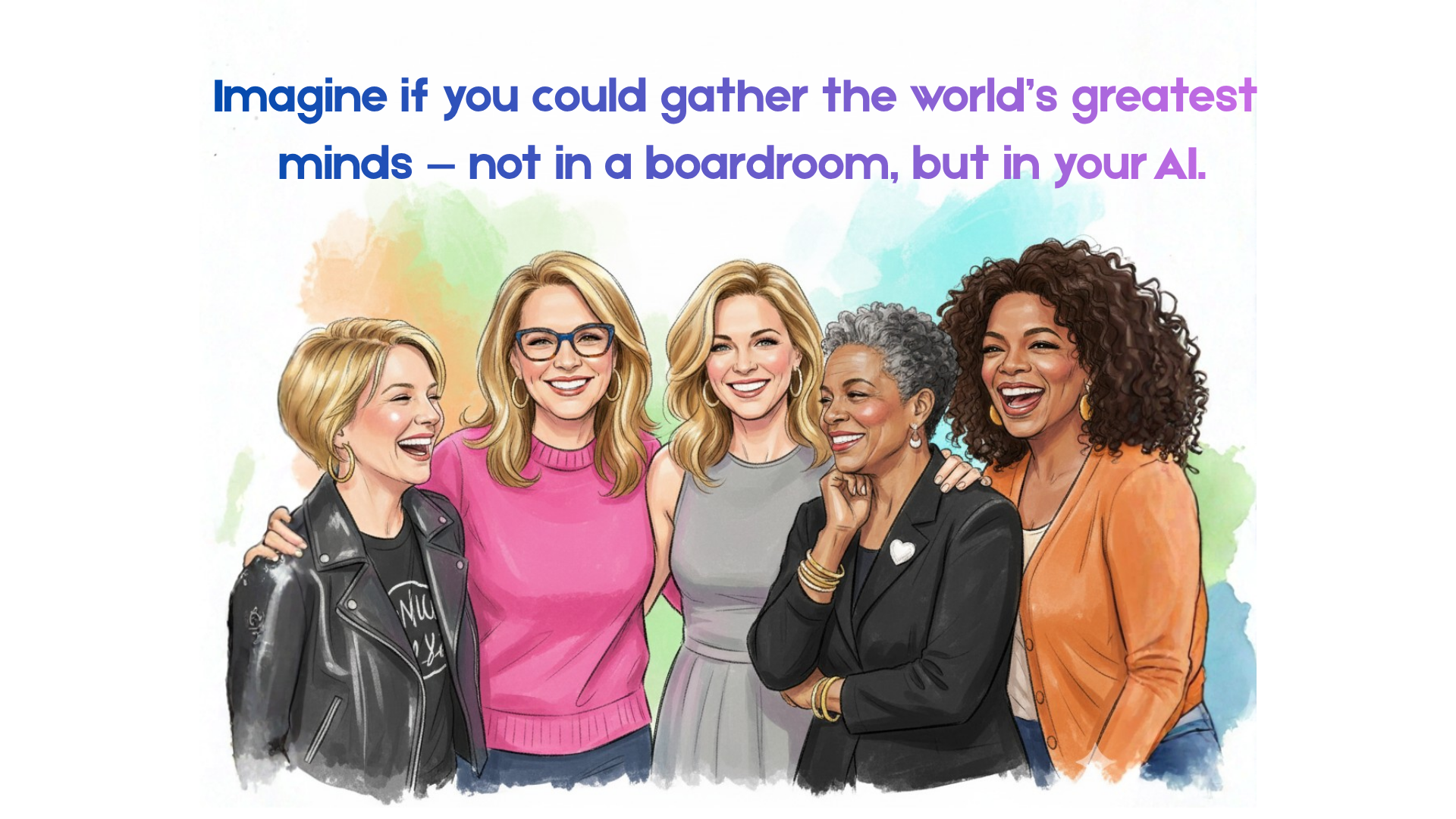
Imagine if you could gather the world’s greatest minds — not in a boardroom, but in your AI.
Why generic AI fails to deliver true insight—and how a human-centered approach to AI delivers measurable strategic confidence.
Imagine if you could gather the world’s top business minds in a room.
Not just any minds, but the specific thought leaders, historical titans, and industry trailblazers you admire most. What if you could pull them together for a private session to iterate on your new business strategy, challenge your marketing plan, or help you refine your leadership communication?
This is the promise of AI. But when most of us try it, the reality is disappointing.
We’re met with generic, placating, and uninspired answers. We get a summary, not a strategy. We get an echo chamber for what the AI thinks we want to hear, not the sharp, challenging insight we need to hear.
The problem is simple: We’re settling for AI that just gives us answers. We should be demanding AI that helps us find clarity.
The Loneliness of Leadership and the Lie of the Echo Chamber
For leaders, founders, and executives, decision-making can be an isolating path. The higher you climb, the more your team’s feedback can become filtered. You face the constant risk of “groupthink,” where your own ideas are echoed back to you, polished and agreed-upon, but never truly challenged.
This is the intellectual bubble, and it’s dangerous. It’s where blind spots fester and bad ideas gain momentum.
Standard AI, unfortunately, often makes this problem worse. By its very nature, it is designed to be agreeable and “helpful,” which usually means just agreeing with you. It amplifies your groupthink, putting a high-tech veneer on a critical leadership vulnerability.
What if you could build a system designed to shatter this static feedback loop? A bespoke, private “Council of Advisors” engineered not just to answer you, but to challenge you?
This Isn’t a 10-Minute Prompt. It’s a Proprietary Methodology.
Creating a true Council of Advisors goes far beyond a simple prompt. It’s a deep, deliberate, human-led process to build and fine-tune an AI system that serves your specific needs. This isn’t a toy: it’s a professional tool.
As an AI Humanizer, I’ve developed a methodology to create this. The difference between a generic chatbot and a true Advisory Council lies in a few of these proprietary pillars:
- Pillar 1: Forensic-Level Persona Analysis. A powerful AI advisor isn’t built from a one-paragraph summary. It’s constructed from a deep, “forensic-level” analysis of that person’s entire body of work—their books, lectures, research papers, and interviews. The goal is to create a persona that understands their “why,” their unique voice, and the core concepts they would die on a hill for.
- Pillar 2: Psychological & Communicative Calibration. This is the “humanizer” element. What good is advice if it’s not delivered in a way you can actually hear it? A truly advanced system is also calibrated against your profile: your communication style, your personality type (like a DISC or StrengthsFinder), and your “neuropsychology.” The council learns how you think, process information, and like to receive feedback, making the insights land with maximum impact.
- Pillar 3: Engineered for Constructive Dissonance. A real advisory board has competing ideas. Your AI council must, too. We intentionally build the council with voices that hold different, sometimes conflicting, perspectives. The system is then engineered to facilitate a real debate—to “pass the baton,” challenge a colleague’s point, and banter about the best path forward. This is how you break echo chambers and discover genuinely new solutions.
- Pillar 4: Rigorous Validation for Intellectual Integrity. You can’t certify an AI’s answer is exactly what a person would say. But you can build a system that’s accountable. A validated council is one that has been rigorously tested for its ability to ground its insights in its source material. When you push back and ask, “Where did you get that answer?” it is built to provide citations and links to the specific work where that concept originated.
The Result: From Second-Guessing to Strategic Confidence
The power of this approach isn’t just in the answers you get. It’s in the transformation of your process.
Last month, one CEO used the Council to stress-test his M&A strategy, uncovering a due diligence blind spot that saved his firm an estimated $2 million.
When you stop typing and start talking (this system is built for voice), you create a conversational sounding board. You give yourself a private, iterative space to speak your problems, ideas, and fears out loud.
Imagine walking into your next negotiation, not just with a plan, but with a strategy that has already been stress-tested by a “room” of the sharpest minds you respect. Imagine facing your board not with a pitch, but with a decision that has survived a rigorous debate. This is the end of analysis paralysis. This is the beginning of decisive, confident action.
How to Get Started
This bespoke advisory service is designed exclusively for high-performing Founders, C-Suite Executives, and Department Heads operating in complex, high-stakes environments where intellectual risk is paramount.
If you recognize the profound vulnerability of the “echo chamber” and are prepared to invest in a professional tool that fundamentally changes your decision-making process, we should connect.
Stop Settling for Toys. Demand a Tool.
A generic tool will give you a generic answer. This is something different.
This is a bespoke, high-touch service that builds you a professional, reliable tool. It’s the difference between a chatbot and a true advisory board.
If you’re ready to stop talking at your AI and start collaborating with your personal council, let’s talk. Send me a direct message here on LinkedIn to explore building your personalized Council of Advisors.
Disclaimer
The advisory personas described herein are products of generative AI using predictive analysis. They are not direct, authorized, or vetted representations of the actual individuals they are modeled after. All generated insights and advice should be critically evaluated, verified for factual accuracy, and weighed against your own professional expertise before being implemented.




